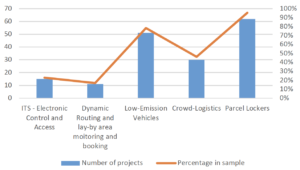A new paper by Cagliano, Mangano, and Zenezini presents an empirical analysis of 65 European cities where different last-mile technologies have been implemented by both private and public operators, aiming to assess the importance of each technology involved and identify adoption trends.
Results show that parcel lockers and low emissions vehicles are the most adopted technologies, while the diffusion of Intelligent Transportation Systems and dynamic routing appears limited. Finally, crowd shipping services are still scattered but show a medium level of adoption.
The results show that parcel lockers together with low emissions vehicles are the most adopted technologies. This might be due to the fact that big players operating at international levels, such as e-commerce companies and logistics service providers, are involved in these projects. On the contrary, the limited diffusion of ITS, or dynamic routing initiatives, is based on the significant support of public authorities that have also to align the different objectives of the stakeholders that are involved. Crowd shipping services are more diffused in countries such as France, the United Kingdom, Norway, and Belgium, wherein logistics startups have experienced a more favorable business environment.
This paper might give support to public policymakers to evaluate their technological maturity in their last-mile systems and then design coherent future objectives. In such a context, the research could drive a more thorough assessment of the impact of public investment against the initial goals, to evaluate the success of urban freight planning strategies. However, this work suffers from some limitations. In particular, the sample is limited to the European contexts and it is not at a worldwide level.
Last-mile appears to be a typical European issue and a low number of municipalities are significantly promoting CL initiatives in other international regions. In fact, European cities have been facing all the problems related to traffic congestions and related pollution for a longer period of time compared with cities of other continents. Also, this work does not take into account the effect of factors that might facilitate the introduction of last-mile services such as the number of startups per inhabitants, or the venture capital funding.
Future research will be addressed to overcome these limitations, by gathering international city projects for enhancing urban logistics systems and by including external aspects that may more precisely explain technology adoption patterns. In particular, such research will be a support in the evaluation of the proposed preliminary results through a more quantitative assessment.

